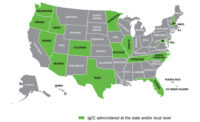The International Code Council has partnered with the American Institute of Architects and the American Society for Testing and Materials to develop an International Green Construction Code that will guide the design and construction of green commercial projects.

The initiative—titled “Safe and Sustainable by the Book”—aims to develop a regulatory framework for green construction that is consistent and coordinated with ICC codes and standards currently adopted nationwide as the basis of building codes. The first draft of the proposed regulations will be presented for public comment in 2010, with publication for adoption expected in 2012.
Since the launch of the initiative in June, a 29-person committee that was formed to draft the new code has hosted public meetings nationwide, engaged in daily conference calls and divided into working groups.
“We are trying to push the envelope, but we’re also trying to be practical in doing so,” says committee vice chair Christopher Green of AGO Studios Inc. in Avon, Colo. “We recognize that collaboration among all the major players is critical to ensuring that the new code makes a smooth transition into the marketplace.”
A resource document written by the ICC staff is being used as a starting point in the drafting process. The document draws upon existing green construction codes, standards and certification programs. Green building codes adopted in California and the city of Aspen are among those referenced in the resource document.
Making the Code Relevant The IGCC committee’s five working groups—energy, water/indoor environmental quality, site/land use, materials and administration—address different chapters of the new code and are all open to outside, interested parties.
Starbucks Coffee Co., Arby’s Restaurant Group and Target have representatives working with the site/land use group, while the Los Angeles Fire Department and the Tile Council of North America are represented on the materials group.
Green says the committee’s greatest challenge is making the code relevant for the next four years until the next code cycle.
“The sustainability arena is rapidly evolving,” he adds. “Rather than adhere to a specific set of criteria that is relevant today, we have to be a bit visionary to accommodate new products and technologies that are not even on the radar yet. Our goal is to develop a code that targets performance and creates an environment where innovation can thrive.”
Always Room for More Regulations in the new code may overlap some requirements of voluntary rating systems...


Post a comment to this article
Report Abusive Comment